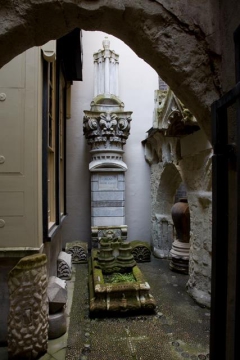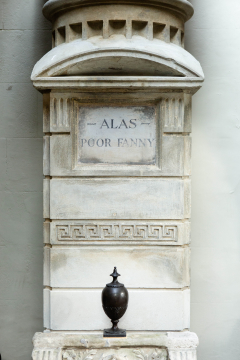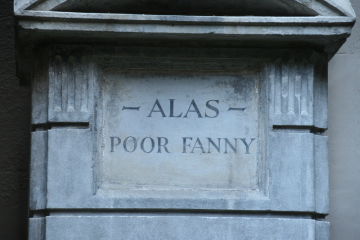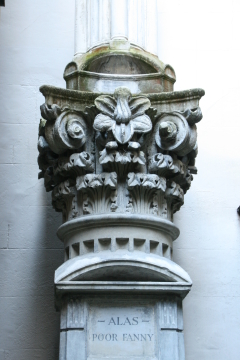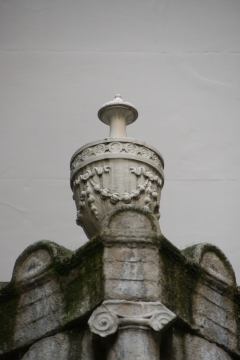Explore Collections


You are here:
CollectionsOnline
/
Column of architectural fragments forming a 'monument' with the inscription ‘Alas Poor Fanny’.
Browse
Column of architectural fragments forming a 'monument' with the inscription ‘Alas Poor Fanny’.
Stone elements topped with a metal (lead) vase
Museum number: MY4
On display: Monk's Yard
All spaces are in No. 13 Lincoln's Inn Fields unless identified as in No. 12, Soane's first house.
For tours https://www.soane.org/your-visit
Curatorial note
Situated in the Monk’s Yard are the sham ruins of the ‘once noble monastery’ of Soane’s imaginary monk 'Padre Giovanni'. At the head of the supposed tomb of this monk is an elaborate colum which is the monument to Mrs Soane’s lapdog, 'Fanny', who died on Christmas Day 1820.
The monument is composed of several elements including two distinctively Soanean carved blocks above and below a carved stone capital based on those of the Roman temple of Vesta at Tivoli, perhaps a spare prototype for those used by Soane at the Bank of England. The monument is topped by a triagular block, perhaps associated with an as yet unidentified Soane architectural project, and a lead urn.
The epitaph on the monument, ‘Alas poor Fanny’, is reminiscent of the famous lines from Shakespeare’s Hamlet: ‘Alas, poor Yorick! I knew him, Horatio: a fellow of infinite jest, of most excellent fancy.’ The seemingly obvious allusion to Shakespeare has led to another possible sorce of inspiration being overlooked – one that would have been equally familiar to Soane and his contemporaries.Soane was a great admirer of the novelist Laurence Sterne, acquiring copies of A Sentimental Journey through France and Italy, Sermons, and Sterne’s Letters as early as 1778, perhaps to take with him on his grand tour. Whilst in Rome in 1779 a friend sent him Sterne’s comic masterpiece The Life and Opinions of Tristram Shandy – a novel which had enjoyed immediate success when the first parts appeared in 1759. Soane quoted from Tristram Shandy and A Sentimental Journey in his lectures and his fondness for Sterne is clear from the annotations in his copies of the books, and from the numbers of copies that he owned. Tristram Shandy is known for its lack of conventional form: the story begins with the eponymous hero’s conception, but breaks into so many detours and imaginary dialogues with the reader that he is not actually born until book 4, and there are numerous typographical oddities such as the use of dashes of various lengths, missing chapters, a blank page where the reader is invited to draw a character’s portrait, and a black page to mark the death of the village parson, Yorick. It contains a famous passage describing the grave where Yorick lies buried ‘under a plain marble slab, … with no more than these three words of inscription, serving both for his epitaph, and elegy’, and on this page the gravestone inscription is printed within a monumental frame: ‘Alas, poor YORICK!’ While Soane may have been quoting Shakespeare, he probably had Sterne’s earlier quotation in mind.
The monument is composed of several elements including two distinctively Soanean carved blocks above and below a carved stone capital based on those of the Roman temple of Vesta at Tivoli, perhaps a spare prototype for those used by Soane at the Bank of England. The monument is topped by a triagular block, perhaps associated with an as yet unidentified Soane architectural project, and a lead urn.
The epitaph on the monument, ‘Alas poor Fanny’, is reminiscent of the famous lines from Shakespeare’s Hamlet: ‘Alas, poor Yorick! I knew him, Horatio: a fellow of infinite jest, of most excellent fancy.’ The seemingly obvious allusion to Shakespeare has led to another possible sorce of inspiration being overlooked – one that would have been equally familiar to Soane and his contemporaries.Soane was a great admirer of the novelist Laurence Sterne, acquiring copies of A Sentimental Journey through France and Italy, Sermons, and Sterne’s Letters as early as 1778, perhaps to take with him on his grand tour. Whilst in Rome in 1779 a friend sent him Sterne’s comic masterpiece The Life and Opinions of Tristram Shandy – a novel which had enjoyed immediate success when the first parts appeared in 1759. Soane quoted from Tristram Shandy and A Sentimental Journey in his lectures and his fondness for Sterne is clear from the annotations in his copies of the books, and from the numbers of copies that he owned. Tristram Shandy is known for its lack of conventional form: the story begins with the eponymous hero’s conception, but breaks into so many detours and imaginary dialogues with the reader that he is not actually born until book 4, and there are numerous typographical oddities such as the use of dashes of various lengths, missing chapters, a blank page where the reader is invited to draw a character’s portrait, and a black page to mark the death of the village parson, Yorick. It contains a famous passage describing the grave where Yorick lies buried ‘under a plain marble slab, … with no more than these three words of inscription, serving both for his epitaph, and elegy’, and on this page the gravestone inscription is printed within a monumental frame: ‘Alas, poor YORICK!’ While Soane may have been quoting Shakespeare, he probably had Sterne’s earlier quotation in mind.
Soane collections online is being continually updated. If you wish to find out more or if you have any further information about this object please contact us: worksofart@soane.org.uk
